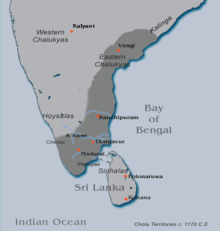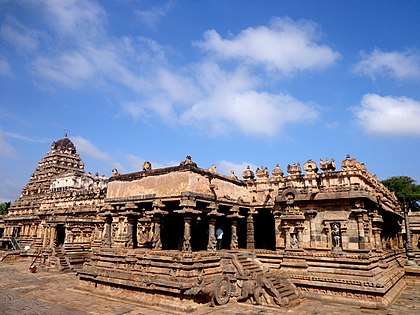Rajaraja II
Rajaraja Chola II (Tamil:இரண்டாம் ராஜராஜ சோழன்) succeeded his father Kulothunga Chola II to the Chola throne in 1150. He was made his heir apparent and coregent in 1146 and so the inscriptions of Rajaraja II count his reign from 1146. Rajaraja's reign began to show signs of the coming end of the dynasty.
| Rajaraja Chola II இரண்டாம் இராஜராஜ சோழன் | |
|---|---|
| Parakesari | |
 Chola territories during 1170 | |
| Reign | 1146–1173 |
| Predecessor | Kulothunga Chola II |
| Successor | Rajadhiraja Chola II |
| Died | 1173 |
| Avanimulududaiyal Bhuvanimulududiyal Ulagudai Mukkokilan | |
| Father | Kulothunga Chola II |
| List of Chola kings and emperors | ||||||||||||||||||||||||||||
|---|---|---|---|---|---|---|---|---|---|---|---|---|---|---|---|---|---|---|---|---|---|---|---|---|---|---|---|---|
| Early Cholas | ||||||||||||||||||||||||||||
| Interregnum (c. 200 – c. 848) | ||||||||||||||||||||||||||||
| Medieval Cholas | ||||||||||||||||||||||||||||
|
||||||||||||||||||||||||||||
| Later Cholas | ||||||||||||||||||||||||||||
|
||||||||||||||||||||||||||||
| Related dynasties | ||||||||||||||||||||||||||||
|
||||||||||||||||||||||||||||
| Chola society | ||||||||||||||||||||||||||||
Growing weakness
The extent of the Chola territories remained as it was during Rajaraja's predecessors. The Vengi country was still firmly under the Chola rule.
The Chola central administration did show weaknesses with regard to their control and effective administration over the outlying parts of the empire, which became pronounced towards the end of Raja Raja-II's reign. However, Raja Raja-II regained adequate control of provinces like Vengi, Kalinga, Pandya and Chera territories. He probably even invaded Sri Lanka as is explained in one of the Tamil poems written during his time. This is borne out by the fact that not just Raja Raja-II, but also his successors like Kulothunga-III bore titles like Tribhuvana Chakravartin attesting to their military capabilities and cultural achievements.
During the last years of Rajaraja's reign, a civil unrest as a result of a succession dispute convulsed the Pandya country, further weakening Chola influence there. This was only to be expected as even though the Pandyas were subjugated by the Cholas since the time of Aditya I and were firmly controlled until the time of Virarajendra, the Madurai kingdom nevertheless kept making efforts from time to time, for gaining their independence from their occupiers. Later Pandyas like Maravarman or Maravaramban Sundara Pandyan, Jatavarman Vira Pandyan and Jatavarman Sundara Pandyan steadily went on increasing their power and prestige and were to emerge as the most powerful kingdom in South India during the period 1200–1300. These developments were to slowly but surely weaken the Chola kingdom, though there was a minor revival during the fairly steady rule of Kulothunga-III (1178–1218).
Inasmuch as the cholas during his time were dominant militarily is noted by some literature that mention Raja Raja's conquest and his innovative management initiatives. Here is excerpt from an inscription of his from the Rajagopala Perumal temple:
..Having won the heart (of the goddess) of the earth for countless ages, (he) was pleased to be seated on the throne of heroes, (made) of pure gold..
while the Villavar (Cheras), Telungar, Minavar (Pandyas),..and other kings prostrated themselves (before him). In the 8th year (of the reign) of (this) king Parakesarivarman, alias the emperor of the three worlds, Sri-Rajarajadeva.[1]
Death and succession
The last regnal year cited in Rajaraja's inscription is 26. That makes the last year of his reign 1173. Rajaraja Chola II was not destined to live long. Rajaraja Chola II did not have any suitable direct descendant to ascend the Chola throne so he chose Rajadhiraja Chola II a grandson of Vikrama Chola as his heir. According to the Pallavarayanpettai inscription, Rajaraja Chola II died four years after he made Rajadhiraja Chola II as heir-apparent.[2] Since, Rajadhiraja himself was quite young, he would require the help of Pallavarayar to usher the young sons of Rajaraja Chola II to safety.[3][4] According to the inscription, Pallavarayar took steps immediately after the death of Rajaraja Chola II for the protection of the king's children, aged one and two years.[3] According to historian Krishnaswami Aiyangar, Kulothunga Chola III who is widely considered as the last great Chola sovereign was the son of Rajaraja II.[5]
Socio-Religious Achievements

One of the most important achievements of Raja Raja-II was that despite being considered a weak king, it appears that he did enjoy periods of calm and peace especially during the later half of his 26-year rule. It was during this period that he initiated construction of the very famous Airavatesvara Temple at Darasuram near Kumbakonam. This royal Siva temple, which is one of the trinity of the Great Living Chola Temples along with the Brihadeeswarar Temple Temples at Thanjavur and Gangaikonda Cholapuram all of which are World Heritage Sites. The Airavateswarar (pictured above)Temple was begun later than at least the Halebidu Temple but was completed earlier, either by the time the rule of Raja Raja-II ended or during the initial period of his successor, Rajadhiraja-II. The Airavateswarar Temple is considered an architectural marvel of the Later Chola period and this tradition was carried on by Kulothunga-III who built the Kampahareswarar Temple at Tribhuvanam in commemoration of his conquest of Madurai, Kalinga, Karuvur and his defeat of the Hoysala King Veera Ballala II. This temple contains innumerable miniature freezes containing stories from Ramayanam, Periya Puranam and other stories devoted to Siva-Parvati, Vinayagar, Karthikeya etc. The temple is also a symbol of continuing architectural tradition of the Chola craftsmen for it also has musical stairs called the Saptasvaras near a small shrine for Ganapati. The Muhamandapam or the Mukhyamandapam of this temple is a real architectural marvel containing many great architectural specimen and was a continuation of the Later Chola tradition of building temples in the shape of giant elephant-driven Rathas or Chariots as like as in Melakadambur siva temple built by kulothunga I, which was also carried on not just by later Chola kings such as Kulothunga-III but also by the kings of Kalinga and culminated in construction of the Sun Temple of Konarak by Eastern Ganga king Narasinghdeo. This is one of the later Chola temples which have remained unparalleled in terms of architectural excellence to date, that left a lasting impression on the succeeding dynasties to the Chola rule.
Raja Raja-II also made numerous grants to the temples at Tanjore, Chidambaram, Kanchi, Srirangam, Tiruchy as well as to the temples at Madurai. He was also believed to be a regular visitor to the temples in Parasurama's country (Kerala), which were also recipients of his grants. During his time the chola navies did remain dominant in the western sea as well as eastern sea.
Overall he was a benevolent king who did putup good management processes, as evidenced by his relief measures to the people during the times of both the famine and civil unrest, which though did take some effort to subdue, but which finally ensured that he retained the loyalty and respect of his ministers, commanders and the general sections of the populace.
Extent of the Empire and Summary of the rule and legacy of Raja Raja-II
Even though there was a famine which further caused a civil disturbance, Raja Raja-II nevertheless, kept most of his adversaries under control and also succeeded in largely maintaining the Chola territories consisting of their possessions in Tamizhagam including Kongunadu, Madurai and Thirunelveli, Nellore-Guntur areas (with Renandu and Telugu Cholas having allegiance to Raja Raja-II but controlling their areas with more authority than before), Visaiyavadai(Vijayawada)-Eluru-Rajahmundry-Prakasham (Draksharama) areas traditionally controlled by Vengi kings, Kalinga (whose King was a tribute paying subordinate and a supportive feudatory to Chola overlordship).. up to the banks of Hooghly. In addition, he also had Northern Sri Lanka (as was the case during the time of his illustrious predecessor, Raja Raja-I) under his loose control while as compared to before, even though he had subdued Chera kings, due to the re-emergence of Pandya power, he was forced to allow more autonomy to Malainadu kings with whom he was believed to be having marital relations. But somehow, Raja Raja-II proved not strong enough to regain control of the eastern Gangavadi province, which was lost to the Hoysalas by his predecessor, the great Vikrama Chola. Possibly, the Hoysalas themselves were trying to free themselves from the control of Western Chalukyas and other rapidly growing adversaries like Kalachuris and Kakatiyas, who were as hostile to the Chalukyas and Hoysalas, as they were to the Cholas and even the Pandyas, as would be evidenced in the later years.
| Preceded by Kulothunga Chola II |
Chola 1146–1173 |
Succeeded by Rajadhiraja Chola II |
Notes
- South Indian Inscriptions: Miscellaneous inscriptions in Tamil (4 pts. in 2), page 81
- Niharranjan Ray; Brajadulal Chattopadhyaya. A Sourcebook of Indian Civilization. Orient Blackswan, 2000 - History - 673 pages. p. 470.
- History of South India, page 158
- The Cholas: mathematics reconstructs the chronology, page 127
- South India and Her Muhammadan Invaders, page 11
References
- History of South India By Pran Nath Chopra, T. K. Ravindran, N. Subrahmanian
- The Cholas: mathematics reconstructs the chronology By N. Sethuraman
- South India and Her Muhammadan Invaders By Krishnaswami S. Aiyangar
- Nilakanta Sastri, K.A. (1935). The CōĻas, University of Madras, Madras (Reprinted 1984).
- Nilakanta Sastri, K.A. (1955). A History of South India, OUP, New Delhi (Reprinted 2002).